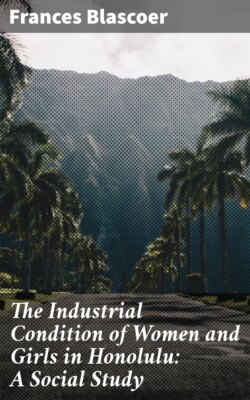Читать книгу The Industrial Condition of Women and Girls in Honolulu: A Social Study - Frances Blascoer - Страница 3
На сайте Литреса книга снята с продажи.
PREFACE
ОглавлениеTable of Contents
In preparing to submit the results of the five-months’ survey of Honolulu’s industrial conditions as they affect women and girls, the definition of a pessimist:—one who has just met an optimist,—has more than once floated warningly through my mind.
In the face of such a warning it is perhaps with mixed feelings one confesses to a conviction that much may be done to solve the problems of the community.
Workrooms are not overcrowded; the air and light are always good; there is no highspeed machinery; no processes dangerous to life and limb are unguarded; fines and penalties are unknown; shop girls work only eight hours a day, have an annual vacation with full pay for two weeks in most shops and of at least one week in all; clerks, stenographers and teachers may well feel that they have found here their earthly paradise both as regards hours and salaries.
As in other tropical communities, the struggle for existence is not agonizing. Even on kona days, throughout which all Honolulu wilts, night brings relief. The meanest tenement in Kakaako is swept by the cool trade winds that come down over the cloud-capped heights of Tantalus during the greater part of the year; and there is no dread of the coming of winter.
Kamaainas say that the aloha of the spirits of departed Hawaiians—who were in life gentle, generous to a fault, loving flowers and music, but caring most of all for their island home—forever guards their former haunts and exhorts all evil.
Honolulu itself tempts one: the Pacific ocean at the waterfront, changing from emerald to purple and sapphire, with the violet glow over all which transfers itself at sunset to the slopes of the grey-green hills backing the city; and between, the bungalow and cottage dotted city itself; most of its squares built up solidly with tiny dwellings surrounded by scarlet and pink flowered hibiscus hedges and shaded by feathery-leaved algarobas, cocoanut and date palms and multi-colored flowering trees; with ferns and vines everywhere.
One must look hard and often at the rectangular and unornamental tenement blocks which obtrude themselves indiscriminately from Kalihi-kai to Waikiki, before one remembers the law of supply and demand which is, alas, still in force although increasingly hard-pressed by public opinion, minimum wage-boards and the Industrial Workers of the World.
Before considering the supply and demand, however, I wish to express to the Board of Trustees of the Kaiulani Home my keen appreciation of the opportunity to make the survey; especially in view of the fact that this work involved a considerable enlargement of the plan they originally had in mind when I was asked to come here. Conditions so clearly indicated the necessity for a comprehensive constructive social program that while a much more detailed piece of work might have been done in the industrial field, I question whether such detail would have developed anything more salient or pertinent than has been shown.
Since progressive thinkers agree that preventive measures make far more surely for social betterment than anything corrective which has yet been evolved, I have endeavored to gather together the measures which have been successfully placed in operation in other communities and to present to you for consideration such of them as fit your needs and conditions.
Three representative bodies engaged in social research: the Bureau of Municipal Research, the Russell Sage Foundation, and the Consumer’s League,—all of New York City—cover practically the entire field and are always at the service of those who wish information or advice.
More personal service is needed everywhere in Honolulu. The best program possible to formulate soon becomes useless anywhere if carried on by unthinking, unprogressive, however well-intentioned methods.
I wish to cordially thank the members of the Executive Committee and of the sub-committees of the Survey, and not the least the wage-earners of the community for the help and encouragement I have had. In spite of queries which briefness of time allotted to the study made it necessary at times to make directly of the latter, I have been received with the utmost good will and helpfulness by workers of all nationalities.
I am especially indebted to the books of Miss Josephine Goldmark, Fatigue and Efficiency; and of Miss Elizabeth Beardsley Butler, Women and the Trades, for valuable information and suggestion. No one interested in the welfare of wage-earners can fail to have his vision widened and clarified by these two pieces of work, prepared with infinite devotion and infinite care in the service of humanity both employing and employed.
